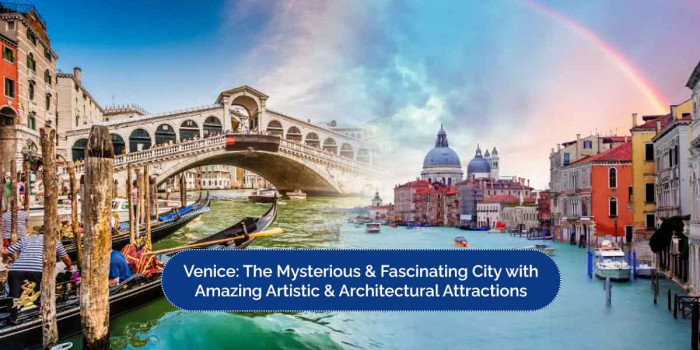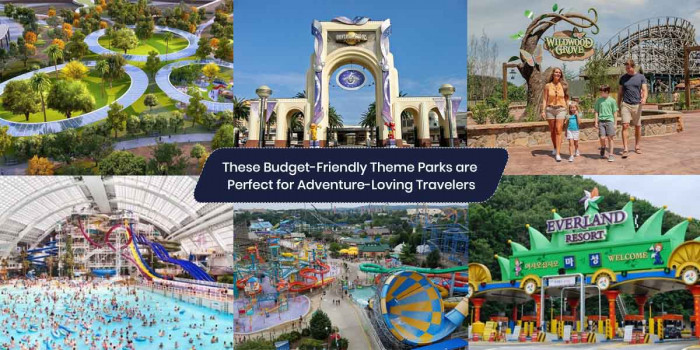5 Classic Attractions That You Should Visit in the Italian City of “Venice”
The mysterious and fascinating city of Italy has several attractions. This romantic city has unique attractions with celebrated art and architecture, gondolas, canals, and great restaurants.

Do you know any romantic place that is the best place for enjoying exotic cuisines and exploring rich art & architecture? Well, Venice in the Veneto region of Italy is the ideal tourist spot for the hopeless romantics and honeymoon couples to relish every moment and create new memories. Here you can go to the opera or classic musical performance, ride gondolas, relish fresh pasta & pastries, visit exhibit halls of an art gallery, and do some high-end shopping.
This ancient and historically important city was the greatest seaport in medieval Europe and is still the major Italian port. Designated as the UNESCO World Heritage site, its spectacular scenic beauty attracts and hosts thousands of tourists every day and millions yearly. The city of Venice is unique environmentally, historically, and architecturally and is one of the world’s oldest tourist and cultural centers. Its incomparable beauty and ambiance can transport you to a whole new world.
Let’s know about the top attractions in Venice, what makes them so amazing, and why they are worth adding to a bucket list.
1. Grand Canal
Grand Canal is a sightseeing attraction for tourists as it is aligned to over 170 very old buildings. The churches, palaces, and waterfront palazzos along this canal can feel like cruising through the painting.
It is one of the most interesting and romantic places in the world, and you will be amazed after you visit it. It is a major center of the Renaissance, which people cross using the classic Venetian boat ‘gondola.’
It forms one of the major water traffic corridors in the city. The canal has fondaco homes in it. Also, a competition named Historical Regatta (Regata Storica) occurs between Venetian boats and is watched by thousands of people from the banks.
The pilgrims to Santa Maria della Salute cross Grand Central on a temporary pontoon bridge from Campo Santa Maria Zobenigo for enjoying stalls & traditional dishes.
2. Piazza San Marco
Known as St. Mark’s Square (in English) or la Piazza (the Square), Piazza San Marco is the principal public square of the city of Venice. Its history is covered in four periods, but only pre-renaissance buildings and monuments are extant.
Those who love labels would surely want to go for the high-end shopping in Piazza San Marco, a central square in Venice. It is also home to various Byzantine mosaics, the Campanile bell, and St. Mark’s Basilica. At its eastern end, the square is dominated by the St. Mark’s Basilica. An open space Piazzetta dei Leoncini is located on the north side of the church.
Its extension is the Piazzetta ("little Piazza/Square") towards the San Marco basin in its southeast corner. According to some sources, Napoleon called Piazza San Marco “the drawing room of Europe.” The other nearby attractions include Procuratie Nuove, Loggetta del Sansovino, St Mark's Campanile, St Mark's Clocktower, and more.
3. St. Mark’s Basilica
St. Mark’s Basilica, also known as the Patriarchal Cathedral Basilica of Saint Mark, is the cathedral church of the Roman Catholic Archdiocese of Venice in northern Italy. One of the best examples of Italo-Byzantine architectures, it is the most famous city church.
On its eastern end lies the Piazza San Marco, which is nearby and connected to the Doge's Palace. It was originally the chapel of Doge and later in 1807 turned into a cathedral when it became the seat of the Patriarch of Venice.
This structure dates back to the 11th century and is since then called Chiesa d'Oro (Church of gold) due to the affluent design, gold ground mosaics, and its status as a symbol of Venetian wealth and power.
The exterior of the church has Horses of Saint Mark-Lysippos, The Tetrarchs, and Narthex or porch. And its spacious interior has Mosaics, treasury, presbytery, and the left & right transepts.
4. Doge’s Palace
Another major landmark in Venice is the Doge’s Palace that’s built in the Venetian Gothicstyle. Constructed in 1340, it was modified and extended in the later centuries. In 1923, it turned into a museum & now happens to be one of the museums operated by the Fondazione Musei Civici di Venezia. Its ceremonial entrance was Porta della Carta that got built between 1438 and 1442, while the public entrance is via the Porta del Frumento located on the waterfront of the building.
Besides, it has other attractions such as a courtyard, Museo dell' Opera, Doge’s apartments, institutional chambers, Old Prison or Piombi, and Bridge of Sighs and the New Prisons. The myriad architectural elements in the palace draw inspiration from the US, UK, Azerbaijan, and Romanian style.
5. Lido Di Venezia
Lido di Venezia, also known as Lido or Venice Lido, is an 11km long barrier island situated in the Venetian Lagoon. It is where the world’s oldest film festival, Venice Film Festival, takes place in late August or early September. It is one of the “Big Three” and the three most prestigious film festivals in the world.
Concluding Thoughts
Besides these, the other top tourist attractions in Venice include Rialto Bridge, Bridge of Sighs, Ca' Rezzonico Museum, Galleria dell’Accademia, Teatro La Fenice, Museo Correr, Peggy Guggenheim Collection, and Basilica of Santa Maria.
The best time to visit the city is summer between the June beginning and July end, which is when it’s the busiest and the most vibrant. Also, if you want to party hard, visit it at the end of February or the beginning of March to attend Venice Carnival.
As some people call it, Venice is undoubtedly the “living museum.” You can also visit the colorful place of Burano, where multicolored houses are there on either side of canals.
Popular Posts
10 Amazing Cities Built Near or Through Rivers
Rivers have been crucial to human settlements, commercialization, and building cities. This opens opportunities for trading goods and establishing international connections.
Kimberly Campbell
20 Most Futuristic Cities In The World
What do you think about the future? Does it bring thrill in you or terrifies you? What’s your take on high speed trains, miles...
Swati Bhandari
Mystery Of Baigong Pipes - 1,50,000 Old Construction Reveals The Ancient Technology
Baigong pipes are a series of ancient pipes found in and near Mount Baigong located about 40-45 km southwest of the city of Deli...
Kevin Green








